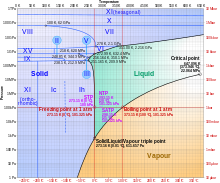Ice Ic
Ice Ic (pronounced "ice one c" or "ice I see") is a metastable cubic crystalline variant of ice. Hans König was the first to identify and deduce the structure of ice Ic.[1] The oxygen atoms in ice Ic are arranged in a diamond structure and is extremely similar to ice Ih having nearly identical densities and the same lattice constant along the hexagonal puckered-planes.[2] It forms at temperatures between 130 and 220 kelvins (−143 and −53 degrees Celsius) upon cooling, and can exist up to 240 K (−33 °C) upon warming,[3][4] when it transforms into ice Ih.

Apart from forming from supercooled water,[5] ice Ic has also been reported to form from amorphous ice[2] as well as from the high-pressure ices II, III and V.[6] It can form in and is occasionally present in the upper atmosphere[7] and is believed to be responsible for the observation of Scheiner's halo, a rare ring that occurs near 28 degrees from the Sun or the Moon.[8]
Ordinary water ice is known as ice Ih (in the Bridgman nomenclature). Different types of ice, from ice II to ice XIX,[9] have been created in the laboratory at different temperatures and pressures.
Some authors have expressed doubts whether ice Ic really has a cubic crystal system, claiming that it is merely stacking-disordered ice I (“ice Isd”),[10][11][12] and it has been dubbed the ″most faceted ice phase in a literal and a more general sense.″[13]
See also[]
- Ice I, for the other crystalline form of ice
References[]
- ^ König, H. (1943). "Eine kubische Eismodifikation". Zeitschrift für Kristallographie (in German). 105 (1): 279–286. doi:10.1524/zkri.1943.105.1.279. S2CID 101738967.
- ^ a b Dowell, L. G.; Rinfret, A. P. (December 1960). "Low-Temperature Forms of Ice as Studied by X-Ray Diffraction". Nature. 188 (4757): 1144–1148. Bibcode:1960Natur.188.1144D. doi:10.1038/1881144a0. ISSN 0028-0836. S2CID 4180631.
- ^ Murray, B.J.; Bertram, A. K. (2006). "Formation and stability of cubic ice in water droplets". Phys. Chem. Chem. Phys. 8 (1): 186–192. Bibcode:2006PCCP....8..186M. doi:10.1039/b513480c. hdl:2429/33770. PMID 16482260.
- ^ Murray, B.J. (2008). "The Enhanced formation of cubic ice in aqueous organic acid droplets". Environmental Research Letters. 3 (2): 025008. Bibcode:2008ERL.....3b5008M. doi:10.1088/1748-9326/3/2/025008.
- ^ Mayer, E.; Hallbrucker, A. (1987). "Cubic ice from liquid water". Nature. 325 (12): 601–602. Bibcode:1987Natur.325..601M. doi:10.1038/325601a0. S2CID 4233237.
- ^ Bertie, J. E.; Calvert, L. D.; Whalley, E. (1963). "Transformations of Ice II, Ice III, and Ice V at Atmospheric Pressure". J. Chem. Phys. 38 (4): 840–846. Bibcode:1963JChPh..38..840B. doi:10.1063/1.1733772.
- ^ Murray, Benjamin J.; Knopf, Daniel A.; Bertram, Allan K. (March 2005). "The formation of cubic ice under conditions relevant to Earth's atmosphere". Nature. 434 (7030): 202–205. Bibcode:2005Natur.434..202M. doi:10.1038/nature03403. ISSN 0028-0836. PMID 15758996. S2CID 4427815.
- ^ Whalley, E. (1981). "Scheiner's Halo: Evidence for Ice Ic in the Atmosphere". Science. 211 (4480): 389–390. Bibcode:1981Sci...211..389W. doi:10.1126/science.211.4480.389. PMID 17748273.
- ^ Flatz, Christian; Hohenwarter, Stefan. "Neue kristalline Eisform aus Innsbruck". Universität Innsbruck (in German). Retrieved 2021-02-18.
- ^ Murray, Benjamin J.; Salzmann, Christoph G.; Heymsfield, Andrew J.; Dobbie, Steven; Neely, Ryan R.; Cox, Christopher J. (2015). "Trigonal Ice Crystals in Earth's Atmosphere" (PDF). Bulletin of the American Meteorological Society. 96 (9): 1519–1531. Bibcode:2015BAMS...96.1519M. doi:10.1175/BAMS-D-13-00128.1.
- ^ Chaplin, Martin (15 September 2019). "Stacking disordered ice; Ice Isd". Water Structure and Science. London South Bank University. Archived from the original on 22 Oct 2020. Retrieved 3 December 2019.
- ^ Malkin, Tamsin L.; Murray, Benjamin J.; Salzmann, Christoph G.; Molinero, Valeria; Pickering, Steven J.; Whale, Thomas F. (2015). "Stacking disorder in ice I". Physical Chemistry Chemical Physics. 17 (1): 60–76. doi:10.1039/C4CP02893G. PMID 25380218.
- ^ Kuhs, W. F.; Sippel, C.; Falenty, A.; Hansen, T. C. (2012). "Extent and relevance of stacking disorder in "ice Ic"". Proceedings of the National Academy of Sciences of the United States of America. 109 (52): 21259–21264. Bibcode:2012PNAS..10921259K. doi:10.1073/pnas.1210331110. PMC 3535660. PMID 23236184.
- Water ice
- Materials stubs
- Physical chemistry stubs
- Inorganic compound stubs